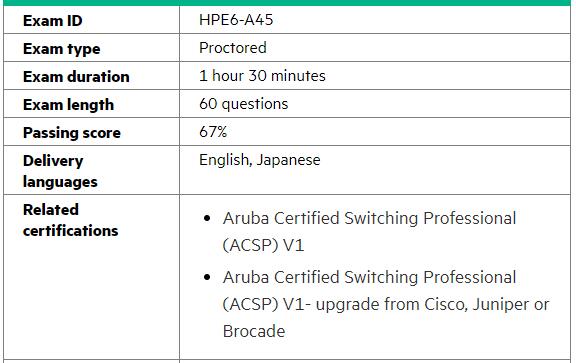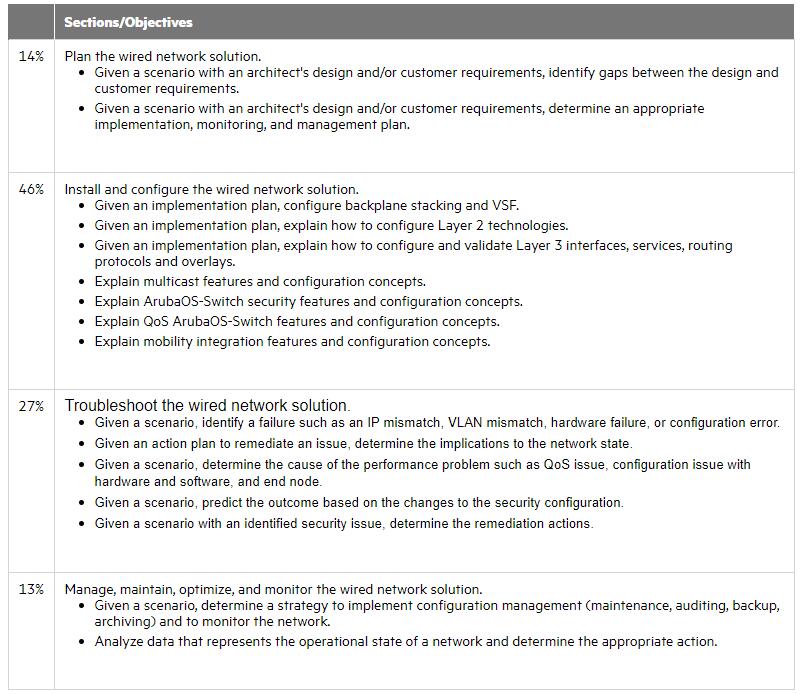HPE6-A45 Practice Test Questions - Implementing Aruba Campus Switching Solutions
HPE6-A45 exam is known as Implementing Aruba Campus Switching Solutions, Passquestion offers the latest HPE6-A45 Practice Test Questions to help you pass your test easily. Passquestion offers you a comprehensive certification test solution to help you become certified professional.HPE6-A45 Practice Test Questions are provided to help candidates to have a clear understanding of the examination pattern and get prepared.
HPE6-A45 Exam description - Implementing Aruba Campus Switching Solutions
HPE6-A45 exam tests your skills with wired configurations of Aruba Mobile First Solutions in complex two-tier and three-tier networks with redundancy. It tests your skills to build to a given implementation plan and deploy consistent wired access control technologies to mirror the wireless access control policies. It also tests your ability to configure specialized applications and security requirements for a LAN.

HPE6-A45 Exam Objectives Tested Your Skills

Download HPE6-A45 Practice Test Questions:
1.An administrator wants to ensure that an AOS-Switch forwards all traffic that it receives on interface 1 with high priority.
-Switches should also communicate the high priority to other switches across the traffic path.
The switch has type of service disabled.
The administrator plans to apply 802.1p priority 5 to interface 1.
What should the administrator check to ensure that the configuration will work properly?
A. Interface 1 receives traffic with a tag.
B. The AOS-Switch is configured to use eight queues.
C. The forwarding path for the traffic uses VLAN tags.
D. An 802.1p-to-DSCP map exists for priority 5.
Answer: A
2.An AOS-Switch implements tunneled node.
Which benefit does the PAPI enhanced security key provide?
A. It validates the signature for firmware pushed to the switch dynamically.
B. It encrypts traffic sent and received by tunneled-node endpoints.
C. It authenticates control traffic between the switch and its Mobility Controller.
D. It provides an extra layer of authentication for endpoints on tunneled-node ports.
Answer: C
3.OSPF Area 1 has two ABRs. One ABR is configured with this range for Area 1: 10.10.0.0/16. The other ABR is not configured with a range for Area 1.
Which type of issue occurs due to this mismatch?
A. The ABRs create a discontinuous area and disrupt intra-area routing between devices within Area 1.
B. The ABR core would send Area 1 traffic destined to the other switch through an access switch.
C. The ABRs lose adjacency entirely and cannot route traffic between each other at all.
D. The ABRs lose adjacency in Area 1 and must route all traffic to each other through Area 0.
Answer: A
4.Refer to the exhibit.
A network administrator configures connection rate filtering on interface 1 with the throttle action. Device 1 crosses the threshold and triggers the action.
What does the switch do?
A. It temporarily drops all IP traffic from Device 1 only.
B. It temporarily drops all IP traffic on interface 1.
C. It drops all IP traffic from Device 1 until the host is manually unblocked.
D. It drops all IP traffic on interface 1 until the interface is manually unblocked.
Answer: A
5.What must an OSPF router do to ensure nonstop routing should a standby member take over as commander when the original VSF commander fails?
A. It must run the shortest path first algorithm.
B. It must participate in a new election for the Designated Router.
C. It must initiate a graceful restart.
D. It must re-establish adjacency with its Designated Router.
Answer: C
6.Two AOS-Switches are directly interconnected. The network administrator wants to prevent broadcast storms and other Layer 2 issues that could occur if there is physical damage to a cable.
Which technology should the administrator implement on the connected switch interfaces?
A. MAC Lockdown
B. Bidirectional Forwarding Detection (BFD)
C. Spanning Tree Root Guard
D. Unidirectional Link Detection (UDLD)
Answer: D
- TOP 50 Exam Questions
-
Exam
All copyrights reserved 2025 PassQuestion NETWORK CO.,LIMITED. All Rights Reserved.

